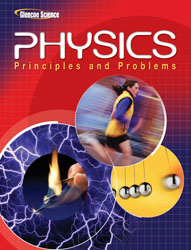1 A) line of reflection B) line of incidence C) normal D) line of refraction 2 A) in a straight line B) in concentric circles C) always toward a dark area D) in a curved line 3 Which statement about the light rays in the figure below is true?
<a onClick="window.open('/olcweb/cgi/pluginpop.cgi?it=jpg::::/sites/dl/free/0078807220/617925/mt.JPG','popWin', 'width=NaN,height=NaN,resizable,scrollbars');" href="#"><img valign="absmiddle" height="16" width="16" border="0" src="/olcweb/styles/shared/linkicons/image.gif"> (13.0K)</a> A) The light originates from the boy's eyes. B) The light originates from the bird's image. C) The image of the bird creates light rays. D) The light originates from the bird. 4 In the figure below, if the flame on the candle is 2 cm tall, how tall is the flame of the image?
<a onClick="window.open('/olcweb/cgi/pluginpop.cgi?it=jpg::::/sites/dl/free/0078807220/617925/mu.JPG','popWin', 'width=NaN,height=NaN,resizable,scrollbars');" href="#"><img valign="absmiddle" height="16" width="16" border="0" src="/olcweb/styles/shared/linkicons/image.gif"> (10.0K)</a> A) 1 cm B) 4 cm C) 8 cm D) 2 cm 5 A) diffuse reflection B) specular reflection C) diffuse refraction D) specular refraction 6 A) behind you B) in front of the mirror C) behind the mirror D) between you and the mirror 7 A) diffuse B) concave C) plane D) convex 8 A) diverge and sight lines diverge and form a real image B) converge and sight lines diverge and form a virtual image C) diverge and sight lines converge and form a virtual image D) converge and sight lines converge and form a real image 9 A) real B) virtual C) convex D) critical 10 A) past the focal point B) twice the distance of the focal point C) between the focal point and mirror D) between the focal point and twice the distance of the focal point 11 A) spherical mirror B) plane mirror C) parabolic mirror D) convex mirror 12 f if you have an object 2.0 m from the concave mirror, and the image is 4.0 m from the mirror?A) 2.0 m B) 1.3 m C) 4.0 m D) 0.67 m 13 If you wanted to adjust the situation in the figure below to produce a real image, which one of the following options by itself would work?
<a onClick="window.open('/olcweb/cgi/pluginpop.cgi?it=jpg::::/sites/dl/free/0078807220/617925/mv.JPG','popWin', 'width=NaN,height=NaN,resizable,scrollbars');" href="#"><img valign="absmiddle" height="16" width="16" border="0" src="/olcweb/styles/shared/linkicons/image.gif"> (9.0K)</a> A) replace the mirror with a convex mirror of the same focal length B) replace the object with a larger object. C) move the object out past the focal point D) replace the mirror with another concave mirror of longer focal length 14 A) 10 B) 2 C) 20 D) 0.5 15 A) A ray B) A real image C) The object D) The focal point 16 A) massive B) negative C) opposite D) positive 17 A) focal length B) foci C) focus point D) focal distance 18 A) the focal point B) the location of the virtual image C) the location of the object D) the center of the mirror 19 In the figure below, if the object is 4 times farther from the mirror than the image, what is the focal length of the mirror?
<a onClick="window.open('/olcweb/cgi/pluginpop.cgi?it=jpg::::/sites/dl/free/0078807220/617925/mw.JPG','popWin', 'width=NaN,height=NaN,resizable,scrollbars');" href="#"><img valign="absmiddle" height="16" width="16" border="0" src="/olcweb/styles/shared/linkicons/image.gif"> (9.0K)</a> A) 0.75 m B) 0.80 m C) 1.25 m D) 1.33 m 20 A) always be projected B) never be virtual C) always be virtual D) always be real 21 In the figure below, if the image is one-third the size of the object and the object is 3.0 m away from the mirror, what is the focal length of the mirror?
<a onClick="window.open('/olcweb/cgi/pluginpop.cgi?it=jpg::::/sites/dl/free/0078807220/617925/mw.JPG','popWin', 'width=NaN,height=NaN,resizable,scrollbars');" href="#"><img valign="absmiddle" height="16" width="16" border="0" src="/olcweb/styles/shared/linkicons/image.gif"> (9.0K)</a> A) -1.5 m B) 3 m C) 0.75 m D) 0.66 m 22 A) image B) focal point C) lens edge D) object














